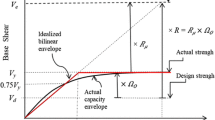Abstract
This research aims to determine the optimum position of single-level, double-level, and multi-level outriggers for 10, 15, and 20 stories at 30, 45, and 60 m in height, respectively. A network of connected shear walls is often used to provide resistance against the lateral stresses that are caused by wind or earthquakes in tall structures. Nevertheless, as structures become higher, lateral stiffness becomes more of a worry; to address this issue, an outrigger may be added between the central core and the outside columns. When the structure is exposed to lateral forces, which would normally cause the core to rotate and result in excessive lateral deflection and the base moment, the outrigger helps to reduce the effects of both of these phenomena. Both symmetrical and asymmetrical outrigger provisions are taken into consideration while designing for the static and seismic stresses, respectively. The structural system is analyzed in 2 dimensions because, when bent in plane, it acts like a vertical cantilever. The values of lateral deflection, lateral drift, and base shear are measured in order to provide an evaluation of performance. The optimum position of a single-level outrigger is H/2, H/2.5, and H/2.85 from the top at 30, 45, and 60 m, respectively. For a two-level outrigger, the optimum position of the second outrigger is H/1, H/1.25, and H/1.4 at 30, 45, and 60 m, respectively (H-height of the building). Key findings from the research on the outrigger system's impact are tabulated and illustrated. The standardized software program ETABS 2019 was utilized for the analysis process.
Access this chapter
Tax calculation will be finalised at checkout
Purchases are for personal use only
Similar content being viewed by others
References
Bayati Z, Mahdikhani M, Rahaei A (2008) Optimized use of multi-outriggers system to stiffen tall buildings. In: The 14th world conference on earthquake engineering, vol 64(2), pp 183–194
Devakumar (2002) Study on the performance of unsymmetrical outrigger braced frames. A thesis submitted in the partial fulfilment of the requirement for the award of Degree of Master of Engineering (Structural Engineering), University of Madras SRM Engineering College, Kattankulathur
Habrah A, Batikha M, Vasdravellis G (2022) An analytical optimization study on the core-outrigger system for efficient design of tall buildings under static lateral loads. J Build Eng 46:103762
IS: 1893:2015 (PART I), Criteria for earthquake resistant design of structures. Bureau of Indian Standards, New Delhi
Mulla AK, Srinivas BN (2015) A study on outrigger system in a tall RC structure with steel bracing. Int J Eng Res 4
Nanduri PRK, Suresh B, Hussain MI (2013) Optimum position of outrigger system for high-rise reinforced concrete buildings under wind and earthquake loadings. Am J Eng Res 2(8):76–89
Netzer I, Lavan O (2020) Optimized seismic design of passively damped outriggers considering perimeter column flexibility. J Struct Eng 146(12):04020254
Sathyanarayan KS, Vijay A, Balachandar S (2012) Feasibility studies on the use of outrigger system for RC core frames. Copyrights© 2012 Votrix Publication (team.ijaiti@gmail.com)
Smith BS, Coull A. Textbook—‘tall building structures: analysis and design’
Thirumurugan V, Satyanarayanan KS, Ganesan TP. Feasibility studies on the use of pneumatic interface for mitigation of disasters in RCC frames with masonry infilling
Author information
Authors and Affiliations
Corresponding author
Editor information
Editors and Affiliations
Rights and permissions
Copyright information
© 2024 The Author(s), under exclusive license to Springer Nature Singapore Pte Ltd.
About this paper
Cite this paper
Naveen Kumar, S., Satyanarayanan, K.S. (2024). Analytical Behavior of Optimum Position of Multi-level Outriggers in RCC Frames. In: Mannan, M.A., Sathyanathan, R., Umamaheswari, N., Chore, H.S. (eds) Emerging Trends in Composite Structures. ICC IDEA 2023. Lecture Notes in Civil Engineering, vol 387. Springer, Singapore. https://doi.org/10.1007/978-981-99-6175-7_25
Download citation
DOI: https://doi.org/10.1007/978-981-99-6175-7_25
Published:
Publisher Name: Springer, Singapore
Print ISBN: 978-981-99-6174-0
Online ISBN: 978-981-99-6175-7
eBook Packages: EngineeringEngineering (R0)




